Neodymium magnet
A neodymium magnet (also known as NdFeB, NIB or Neo magnet) is the most widely used[1] type of rare-earth magnet. It is a permanent magnet made from an alloy of neodymium, iron, and boron to form the Nd2Fe14B tetragonal crystalline structure.[2] Developed independently in 1984 by General Motors and Sumitomo Special Metals,[3][4][5] neodymium magnets are the strongest type of permanent magnet available commercially.[2][6] Because of different manufacturing processes, they are divided into two subcategories, namely sintered NdFeB magnets and bonded NdFeB magnets.[7][8] They have replaced other types of magnets in many applications in modern products that require strong permanent magnets, such as electric motors in cordless tools, hard disk drives and magnetic fasteners.

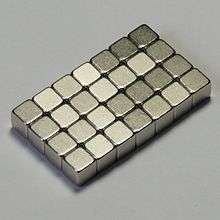

History
General Motors (GM) and Sumitomo Special Metals independently discovered the Nd2Fe14B compound almost simultaneously in 1984.[3] The research was initially driven by the high raw materials cost of SmCo permanent magnets, which had been developed earlier. GM focused on the development of melt-spun nanocrystalline Nd2Fe14B magnets, while Sumitomo developed full-density sintered Nd2Fe14B magnets. GM commercialized its inventions of isotropic Neo powder, bonded neo magnets, and the related production processes by founding Magnequench in 1986 (Magnequench has since become part of Neo Materials Technology, Inc., which later merged into Molycorp). The company supplied melt-spun Nd2Fe14B powder to bonded magnet manufacturers. The Sumitomo facility became part of the Hitachi Corporation, and has manufactured but also licensed other companies to produce sintered Nd2Fe14B magnets. Hitachi has held more than 600 patents covering neodymium magnets.[9]
Chinese manufacturers have become a dominant force in neodymium magnet production, based on their control of much of the world's sources of rare earth mines.[10]
The United States Department of Energy has identified a need to find substitutes for rare earth metals in permanent magnet technology and has funded such research. The Advanced Research Projects Agency-Energy has sponsored a Rare Earth Alternatives in Critical Technologies (REACT) program, to develop alternative materials. In 2011, ARPA-E awarded 31.6 million dollars to fund Rare-Earth Substitute projects.[11] Because of its role in permanent magnets used for wind turbines, it has been argued that neodymium will be one of the main objects of geopolitical competition in a world running on renewable energy. But this perspective has been criticized for failing to recognize that most wind turbines do not use permanent magnets and for underestimating the power of economic incentives for expanded production.[12]
Composition
Neodymium is a metal which is ferromagnetic (more specifically it shows antiferromagnetic properties), meaning that like iron it can be magnetized to become a magnet, but its Curie temperature (the temperature above which its ferromagnetism disappears) is 19 K (−254.2 °C; −425.5 °F), so in pure form its magnetism only appears at extremely low temperatures.[13] However, compounds of neodymium with transition metals such as iron can have Curie temperatures well above room temperature, and these are used to make neodymium magnets.
The strength of neodymium magnets is the result of several factors. The most important is that the tetragonal Nd2Fe14B crystal structure has exceptionally high uniaxial magnetocrystalline anisotropy (HA ≈ 7 T – magnetic field strength H in units of A/m versus magnetic moment in A·m2).[14][3] This means a crystal of the material preferentially magnetizes along a specific crystal axis but is very difficult to magnetize in other directions. Like other magnets, the neodymium magnet alloy is composed of microcrystalline grains which are aligned in a powerful magnetic field during manufacture so their magnetic axes all point in the same direction. The resistance of the crystal lattice to turning its direction of magnetization gives the compound a very high coercivity, or resistance to being demagnetized.
The neodymium atom can have a large magnetic dipole moment because it has 4 unpaired electrons in its electron structure[15] as opposed to (on average) 3 in iron. In a magnet it is the unpaired electrons, aligned so they spin in the same direction, which generate the magnetic field. This gives the Nd2Fe14B compound a high saturation magnetization (Js ≈ 1.6 T or 16 kG) and a remnant magnetization of typically 1.3 teslas. Therefore, as the maximum energy density is proportional to Js2, this magnetic phase has the potential for storing large amounts of magnetic energy (BHmax ≈ 512 kJ/m3 or 64 MG·Oe). This magnetic energy value is about 18 times greater than "ordinary" ferrite magnets by volume and 12 times by mass. This magnetic energy property is higher in NdFeB alloys than in samarium cobalt (SmCo) magnets, which were the first type of rare-earth magnet to be commercialized. In practice, the magnetic properties of neodymium magnets depend on the alloy composition, microstructure, and manufacturing technique employed.
The Nd2Fe14B crystal structure can be described as alternating layers of iron atoms and a neodymium-boron compound.[3] The diamagnetic boron atoms do not contribute directly to the magnetism but improve cohesion by strong covalent bonding.[3] The relatively low rare earth content (12% by volume) and the relative abundance of neodymium and iron compared with samarium and cobalt makes neodymium magnets lower in price than samarium-cobalt magnets.[3]
Properties
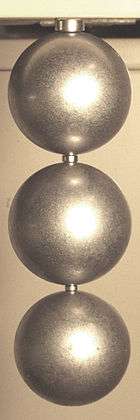

Grades
Neodymium magnets are graded according to their maximum energy product, which relates to the magnetic flux output per unit volume. Higher values indicate stronger magnets. For sintered NdFeB magnets, there is a widely recognized international classification. Their values range from 28 up to 52. The first letter N before the values is short for neodymium, meaning sintered NdFeB magnets. Letters following the values indicate intrinsic coercivity and maximum operating temperatures (positively correlated with the Curie temperature), which range from default (up to 80 °C or 176 °F) to AH (230 °C or 446 °F).[16][17]
Grades of sintered NdFeB magnets:[7][18]
- N30 – N52
- N30M – N50M
- N30H – N50H
- N30SH – N48SH
- N30UH – N42UH
- N28EH – N40EH
- N28AH – N35AH
Magnetic properties
Some important properties used to compare permanent magnets are:
- Remanence (Br), which measures the strength of the magnetic field.
- Coercivity (Hci), the material's resistance to becoming demagnetized.
- (Maximum) Energy product (BHmax), the density of magnetic energy,[19] characterized by the maximum value of magnetic flux density(B) times magnetic field strength (H).
- Curie temperature (TC), the temperature at which the material loses its magnetism.
Neodymium magnets have higher remanence, much higher coercivity and energy product, but often lower Curie temperature than other types of magnets. Special neodymium magnet alloys that include terbium and dysprosium have been developed that have higher Curie temperature, allowing them to tolerate higher temperatures.[20] The table below compares the magnetic performance of neodymium magnets with other types of permanent magnets.
| Magnet | Br (T) |
Hci (kA/m) |
BHmax (kJ/m3) |
TC | |
|---|---|---|---|---|---|
| (°C) | (°F) | ||||
| Nd2Fe14B, sintered | 1.0–1.4 | 750–2000 | 200–440 | 310–400 | 590–752 |
| Nd2Fe14B, bonded | 0.6–0.7 | 600–1200 | 60–100 | 310–400 | 590–752 |
| SmCo5, sintered | 0.8–1.1 | 600–2000 | 120–200 | 720 | 1328 |
| Sm(Co, Fe, Cu, Zr)7, sintered | 0.9–1.15 | 450–1300 | 150–240 | 800 | 1472 |
| Alnico, sintered | 0.6–1.4 | 275 | 10–88 | 700–860 | 1292–1580 |
| Sr-ferrite, sintered | 0.2–0.78 | 100–300 | 10–40 | 450 | 842 |
Physical and mechanical properties

| Property | Neodymium | Sm-Co |
|---|---|---|
| Remanence (T) | 1–1.5 | 0.8–1.16 |
| Coercivity (MA/m) | 0.875–2.79 | 0.493–2.79 |
| Relative permeability | 1.05 | 1.05–1.1 |
| Temperature coefficient of remanence (%/K) | −(0.12–0.09) | −(0.05–0.03) |
| Temperature coefficient of coercivity (%/K) | −(0.65–0.40) | −(0.30–0.15) |
| Curie temperature (°C) | 310–370 | 700–850 |
| Density (g/cm3) | 7.3–7.7 | 8.2–8.5 |
| Thermal expansion coefficient, parallel to magnetization (1/K) | (3–4)×10−6 | (5–9)×10−6 |
| Thermal expansion coefficient, perpendicular to magnetization (1/K) | (1–3)×10−6 | (10–13)×10−6 |
| Flexural strength (N/mm2) | 200–400 | 150–180 |
| Compressive strength (N/mm2) | 1000–1100 | 800–1000 |
| Tensile strength (N/mm2) | 80–90 | 35–40 |
| Vickers hardness (HV) | 500–650 | 400–650 |
| Electrical resistivity (Ω·cm) | (110–170)×10−6 | (50–90)×10−6 |
Corrosion problems
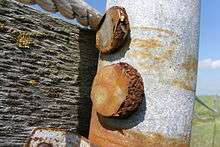
Sintered Nd2Fe14B tends to be vulnerable to corrosion, especially along grain boundaries of a sintered magnet. This type of corrosion can cause serious deterioration, including crumbling of a magnet into a powder of small magnetic particles, or spalling of a surface layer.
This vulnerability is addressed in many commercial products by adding a protective coating to prevent exposure to the atmosphere. Nickel plating or two-layered copper-nickel plating are the standard methods, although plating with other metals, or polymer and lacquer protective coatings, are also in use.[23]
Temperature effects
Neodymium has a negative coefficient, meaning the coercivity along with the magnetic energy density (BHmax) decreases with temperature. Neodymium-iron-boron magnets have high coercivity at room temperature, but as the temperature rises above 100 °C (212 °F), the coercivity decreases drastically until the Curie temperature (around 320 °C or 608 °F). This fall in coercivity limits the efficiency of the magnet under high-temperature conditions such as in wind turbines, hybrid motors, etc. Dysprosium (Dy) or terbium (Tb) is added to curb the fall in performance from temperature changes, making the magnet even more expensive.[24]
Hazards
The greater forces exerted by rare-earth magnets create hazards that may not occur with other types of magnet. Neodymium magnets larger than a few cubic centimeters are strong enough to cause injuries to body parts pinched between two magnets, or a magnet and a ferrous metal surface, even causing broken bones.[25]
Magnets that get too near each other can strike each other with enough force to chip and shatter the brittle magnets, and the flying chips can cause various injuries, especially eye injuries. There have even been cases where young children who have swallowed several magnets have had sections of the digestive tract pinched between two magnets, causing injury or death. Also this could be a serious health risk if working with machines that have magnets in or attached to them [26] The stronger magnetic fields can be hazardous to mechanical and electronic devices, as they can erase magnetic media such as floppy disks and credit cards, and magnetize watches and the shadow masks of CRT type monitors at a greater distance than other types of magnet. In some cases, chipped magnets can act as a fire hazard as they come together, sending sparks flying as if it were a lighter flint, because some neodymium magnets contain ferrocerium.
Production
There are two principal neodymium magnet manufacturing methods:
- Classical powder metallurgy or sintered magnet process[27]
- Sintered Nd-magnets are prepared by the raw materials being melted in a furnace, cast into a mold and cooled to form ingots. The ingots are pulverized and milled; the powder is then sintered into dense blocks. The blocks are then heat-treated, cut to shape, surface treated and magnetized.
- Rapid solidification or bonded magnet process
- Bonded Nd-magnets are prepared by melt spinning a thin ribbon of the NdFeB alloy. The ribbon contains randomly oriented Nd2Fe14B nano-scale grains. This ribbon is then pulverized into particles, mixed with a polymer, and either compression- or injection-molded into bonded magnets.
In 2015, Nitto Denko Corporation of Japan announced their development of a new method of sintering neodymium magnet material. The method exploits an "organic/inorganic hybrid technology" to form a clay-like mixture that can be fashioned into various shapes for sintering. Most importantly, it is said to be possible to control a non-uniform orientation of the magnetic field in the sintered material to locally concentrate the field to, e.g., improve the performance of electric motors. Mass production is planned for 2017.[28][29]
As of 2012, 50,000 tons of neodymium magnets are produced officially each year in China, and 80,000 tons in a "company-by-company" build-up done in 2013.[30] China produces more than 95% of rare earth elements and produces about 76% of the world's total rare-earth magnets, as well as most of the world's neodymium.[31][9]
Applications
Existing magnet applications
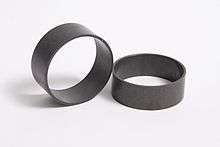
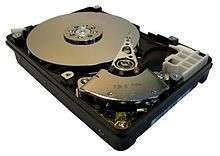
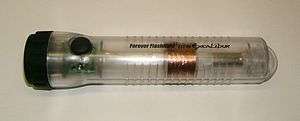
Neodymium magnets have replaced alnico and ferrite magnets in many of the myriad applications in modern technology where strong permanent magnets are required, because their greater strength allows the use of smaller, lighter magnets for a given application. Some examples are:
- Head actuators for computer hard disks
- Mechanical e-cigarette firing switches
- Locks for doors
- Loudspeakers and headphones
- Mobile phone speakers, taptic feedback and auto focus actuators
- Magnetic bearings and couplings
- Benchtop NMR spectrometers
- Electric motors: (Using neodymium magnets in electric motors can reduce their power consumption by half.)[32]
- Cordless tools
- Servomotors
- Lifting and compressor motors
- Synchronous motors
- Spindle and stepper motors
- Electrical power steering
- Drive motors for hybrid and electric vehicles. The electric motors of each Toyota Prius require one kilogram (2.2 lb) of neodymium.[20]
- Actuators
- Electric generators for wind turbines (only those with permanent magnet excitation)
- Alignment of nanocellulose chiral nematic suspensions to fabricate cellulose nanocrystals films with tuneable specular and off-specular optical response [33]
- Voice coil[34]
- Retail media case decouplers
- In process industries, powerful neodymium magnets are used to catch foreign bodies and protect product and processes[35]
New applications
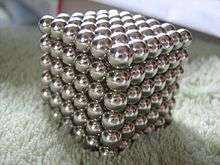
The greater strength of neodymium magnets has inspired new applications in areas where magnets were not used before, such as magnetic jewelry clasps, children's magnetic building sets (and other neodymium magnet toys) and as part of the closing mechanism of modern sport parachute equipment.[36] They are the main metal in the formerly popular desk-toy magnets, "Buckyballs" and "Buckycubes", though some U.S. retailers have chosen not to sell them because of child-safety concerns,[37] and they have been banned in Canada for the same reason.[38]
The strength and magnetic field homogeneity on neodymium magnets has also opened new applications in the medical field with the introduction of open magnetic resonance imaging (MRI) scanners used to image the body in radiology departments as an alternative to superconducting magnets that use a coil of superconducting wire to produce the magnetic field.[39]
Neodymium magnets are used as a surgically placed anti-reflux system which is a band of magnets[40] surgically implanted around the lower esophageal sphincter to treat gastroesophageal reflux disease (GERD).[41] They have also been implanted in the fingertips in order to provide sensory perception of magnetic fields,[42] though this is an experimental procedure only popular among biohackers and grinders.[43]
See also
- Lanthanide – Trivalent metallic rare earth elements
- Magnet fishing – Searching in outdoor waters for ferromagnetic objects
References
- "What is a Strong Magnet?". The Magnetic Matters Blog. Adams Magnetic Products. October 5, 2012. Retrieved October 12, 2012.
- Fraden, Jacob (2010). Handbook of Modern Sensors: Physics, Designs, and Applications, 4th Ed. USA: Springer. p. 73. ISBN 978-1441964656.
- Lucas, Jacques; Lucas, Pierre; Le Mercier, Thierry; et al. (2014). Rare Earths: Science, Technology, Production and Use. Elsevier. pp. 224–225. ISBN 978-0444627445.
- M. Sagawa; S. Fujimura; N. Togawa; H. Yamamoto; Y. Matsuura (1984). "New material for permanent magnets on a base of Nd and Fe (invited)". Journal of Applied Physics. 55 (6): 2083. Bibcode:1984JAP....55.2083S. doi:10.1063/1.333572.
- J. J. Croat; J. F. Herbst; R. W. Lee; F. E. Pinkerton (1984). "Pr‐Fe and Nd‐Fe‐based materials: A new class of high‐performance permanent magnets (invited)". Journal of Applied Physics. 55 (6): 2078. doi:10.1063/1.333571.
- "What are neodymium magnets?". wiseGEEK website. Conjecture Corp. 2011. Retrieved October 12, 2012.
- Sintered NdFeB Magnets, What are Sintered NdFeB Magnets?
- Bonded NdFeB Magnets, What are Bonded NdFeB Magnets?
- Chu, Steven. Critical Materials Strategy United States Department of Energy, December 2011. Accessed: 23 December 2011.
- Peter Robison & Gopal Ratnam (29 September 2010). "Pentagon Loses Control of Bombs to China Metal Monopoly". Bloomberg News. Retrieved 24 March 2014.
- "Research Funding for Rare Earth Free Permanent Magnets". ARPA-E. Retrieved 23 April 2013.
- Overland, Indra (2019-03-01). "The geopolitics of renewable energy: Debunking four emerging myths". Energy Research & Social Science. 49: 36–40. doi:10.1016/j.erss.2018.10.018. ISSN 2214-6296.
- Chikazumi, Soshin (2009). Physics of Ferromagnetism, 2nd Ed. OUP Oxford. p. 187. ISBN 978-0191569852.
- "Magnetic Anisotropy". Hitchhiker's Guide to Magnetism. Retrieved 2 March 2014.
- Boysen, Earl; Muir, Nancy C. (2011). Nanotechnology For Dummies, 2nd Ed. John Wiley and Sons. p. 167. ISBN 978-1118136881.
- How to Understand the Grade of Sintered NdFeB Magnet?, Grades of Sintered NdFeB Magnets
- "Magnet Grade Chart". Amazing Magnets, LLC. Retrieved December 4, 2013.
- "Grades of Neodymium magnets" (PDF). Everbeen Magnet. Retrieved December 6, 2015.
- "What is Maximum Energy Product / BHmax and How Does It Correspond to Magnet Grade? | Dura Magnetics USA". Retrieved 2020-01-20.
- As hybrid cars gobble rare metals, shortage looms, Reuters, August 31, 2009.
- Juha Pyrhönen; Tapani Jokinen; Valéria Hrabovcová (2009). Design of Rotating Electrical Machines. John Wiley and Sons. p. 232. ISBN 978-0-470-69516-6.
- Typical Physical and Chemical Properties of Some Magnetic Materials, Permanent Magnets Comparison and Selection.
- Drak, M.; Dobrzanski, L.A. (2007). "Corrosion of Nd-Fe-B permanent magnets" (PDF). Journal of Achievements in Materials and Manufacturing Engineering. 20 (1–2). Archived from the original (PDF) on 2012-04-02.
- Gauder, D. R.; Froning, M. H.; White, R. J.; Ray, A. E. (15 April 1988). "Elevated temperature study of Nd‐Fe‐B–based magnets with cobalt and dysprosium additions". Journal of Applied Physics. 63 (8): 3522–3524. doi:10.1063/1.340729.
- Swain, Frank (March 29, 2018). "How to remove a finger with two super magnets". The Sciencepunk Blog. Seed Media Group LLC. Retrieved 2009-06-28.
- "CPSC Safety Alert: Ingested Magnets Can Cause Serious Intestinal Injuries" (PDF). U.S. Consumer Product Safety Commission. Archived from the original (PDF) on 8 January 2013. Retrieved 13 December 2012.
- "Manufacturing Process of Sintered Neodymium Magnets". American Applied Materials Corporation. Archived from the original on 2015-05-26.
- "World's First Magnetic Field Orientation Controlling Neodymium Magnet". Nitto Denko Corporation. 24 August 2015. Retrieved 28 September 2015.
- "Potent magnet that can be molded like clay developed". Asahi Shimbun. 28 August 2015. Archived from the original on 28 September 2015. Retrieved 28 September 2015.
- "The Permanent Magnet Market – 2015" (PDF). Magnetics 2013 Conference. Magnetics 2013 Conference. February 7, 2013. Retrieved November 28, 2013.
- Isaak, Adam (October 19, 2018). "A rare metal called neodymium is in your headphones, cellphone and electric cars like Tesla's Model 3 — and China controls the world's supply". CNBC.
- "How its made - Neodymium magnets كيفية صناعة المغناطيسات الخارقة القوة" – via www.youtube.com.
- Frka‐Petesic, Bruno; Guidetti, Giulia; Kamita, Gen; Vignolini, Silvia (1 August 2017). "Controlling the Photonic Properties of Cholesteric Cellulose Nanocrystal Films with Magnets". Advanced Materials. 29 (32): 1701469. doi:10.1002/adma.201701469. PMID 28635143.
- Constantinides, Steve (2012). "The Demand for Rare Earth Materials In Permanent Magnets" (PDF). www.magmatllc.com. Steve Constantinides. Archived from the original (PDF) on 29 March 2018. Retrieved 26 March 2018.
- "Industrial Magnets strength and design for process protections - PowderProcess.net".
- "Options Guide". United Parachute Technologies. Archived from the original on July 17, 2011.
- O'Donnell, Jayne (July 26, 2012). "Feds file suit against Buckyballs, retailers ban product". USA Today.
- "Health Canada to ban the sale of 'Buckyballs' magnets". CTVNews. 2013-04-16. Retrieved 2018-08-22.
- Elster, Allen D. "MRI magnet design". Questions and Answers in MRI. Retrieved 2018-12-26.
- "TAVAC Safety and Effectiveness Analysis: LINX® Reflux Management System". Archived from the original on 2014-02-14.
- "The linx reflux management system: stop reflux at its source". Torax Medical Inc.
- Dvorsky, George. "What You Need to Know About Getting Magnetic Finger Implants". Retrieved 2016-09-30.
- I.Harrison, K.Warwick and V.Ruiz (2018), "Subdermal Magnetic Implants: An Experimental Study", Cybernetics and Systems, 49(2), 122-150.
Further reading
- MMPA 0100-00, Standard Specifications for Permanent Magnet Materials
- K.H.J. Buschow (1998) Permanent-Magnet Materials and their Applications, Trans Tech Publications Ltd., Switzerland, ISBN 0-87849-796-X
- Campbell, Peter (1994). Permanent Magnet Materials and their Application. Permanent Magnet Materials and Their Application. p. 217. Bibcode:1996pmma.book.....C. ISBN 978-0-521-24996-6.
- Furlani, Edward P. (2001). Permanent Magnet and Electromechanical Devices: Materials, Analysis and Applications. London: Academic Press. ISBN 978-0-12-269951-1.
- Brown, D; Ma, Bao-Min; Chen, Zhongmin (2002). "Developments in the processing and properties of NdFeB-type permanent magnets". Journal of Magnetism and Magnetic Materials. 248 (3): 432–440. Bibcode:2002JMMM..248..432B. doi:10.1016/S0304-8853(02)00334-7.
- The Dependence of Magnetic Properties and Hot Workability of Rare Earth-Iron-Boride Magnets Upon Composition.
External links
- Bowley, Roger. "More with Magnets". Sixty Symbols. Brady Haran for the University of Nottingham.
- Geeky Rare-Earth Magnets Repel Sharks
- Concern as China clamps down on rare earth exports